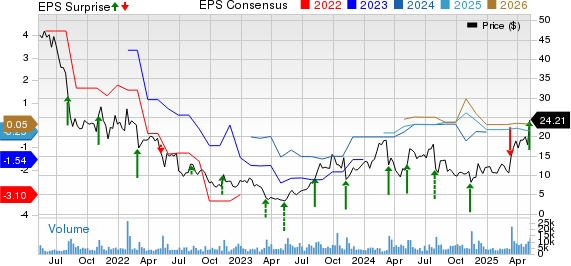Coffee Prices Fluctuate Amid Supply Concerns and Weather Challenges
May arabica coffee (KCK25) is down -4.50 (-1.15%) today, while May ICE robusta coffee (RMK25) remains unchanged. Generally, coffee prices are lower, primarily influenced by a two-week high in the dollar index (DXY00), which is pressuring commodity prices, including coffee. Nonetheless, the decline in robusta coffee is constrained due to crop concerns in Vietnam. The Dak Lak weather office announced that the Central Highlands, Vietnam’s primary coffee-producing region, will encounter hotter temperatures and reduced rainfall from March 21 to 31. As the world’s largest producer of robusta coffee beans, Vietnam’s weather patterns significantly impact global supply.
Commodity Bulletin: From crude oil to coffee, this FREE newsletter serves both industry professionals and newcomers.
In the robusta market, an increase in supplies negatively affects prices. ICE-monitored robusta coffee inventories reached a six-week high today of 4,360 lots. Conversely, ICE-monitored arabica coffee inventories dropped to a one-month low of 782,489 bags on Thursday.
Worrisome rainfall deficits in Brazil pose a threat to coffee crops, fostering a bullish sentiment for prices. Somar Meteorologia reported that Brazil’s main arabica coffee area, Minas Gerais, received only 30.8 mm of rain for the week ending March 15, which is 71% of the historical average. On Thursday, arabica coffee’s upward momentum continued after Cooxupe, Brazil’s largest arabica coffee cooperative, indicated that high temperatures and insufficient rainfall last month could adversely affect yields this year.
Supply fears continue to buoy coffee prices. Last Thursday, Cecafe reported that Brazil’s February green coffee exports decreased by -12% year-over-year to 3 million bags. Additionally, on January 28, Conab, Brazil’s government crop forecasting agency, projected a -4.4% year-over-year drop in Brazil’s 2025/26 coffee crop to a three-year low of 51.81 million bags. Furthermore, Conab revised its 2024 Brazil coffee crop estimate down by -1.1% to 54.2 million bags from an earlier projection of 54.8 million bags.
Additionally, on the bearish side for coffee, Marex Solutions reported on March 7 that the global coffee surplus for the 2025/26 season is expected to increase to 1.2 million bags from +200,000 bags in the 2024/25 season.
A bearish signal for robusta coffee emerged from Vietnam’s General Statistics Office, which reported that February coffee exports rose +6.6% year-over-year to 169,000 MT.
The lingering effects of last year’s dry El Nino weather could result in long-term damage to coffee crops in South and Central America. Since last April, Brazil has experienced consistent rainfall deficits, affecting coffee trees during the critical flowering stage and reducing projections for the 2025/26 arabica coffee crop. According to Cemaden, Brazil is facing its driest weather in 42 years. Meanwhile, Colombia, the world’s second-largest arabica producer, is slowly recovering from the previous year’s drought linked to El Nino.
Reduced robusta production continues to support robusta coffee prices. Due to drought conditions, Vietnam’s coffee production for the 2023/24 crop year is projected to decline by -20% to 1.472 MMT, the smallest crop in four years. The USDA FAS forecast on May 31 anticipates Vietnam’s robusta coffee production for the upcoming 2024/25 marketing year to decrease slightly to 27.9 million bags from 28 million bags in 2023/24. The Vietnam General Statistics Office also reported that 2024 Vietnam coffee exports fell -17.1% year-over-year to 1.35 MMT. Furthermore, the Vietnam Coffee and Cocoa Association announced a reduction in its 2024/25 production estimate to 26.5 million bags from 28 million bags.
On a global scale, increased coffee exports may negatively impact prices. Conab reported on February 4 that Brazil’s 2024 coffee exports rose +28.8% year-over-year to reach a record 50.5 million bags. Nevertheless, ICO reported on February 6 that global coffee exports in December fell -12.4% year-over-year to 10.73 million bags, while October to December exports declined by -0.8% year-over-year to 32.25 million bags.
The USDA’s biannual report, released on December 18, presented mixed signals for coffee prices. The USDA’s Foreign Agriculture Service (FAS) projected an increase of +4.0% year-over-year in world coffee production for 2024/25 to 174.855 million bags, including a +1.5% rise in arabica production to 97.845 million bags and a +7.5% rise in robusta production to 77.01 million bags. The USDA’s FAS also expects that ending stocks for 2024/25 will decrease by -6.6% to a 25-year low of 20.867 million bags, down from 22.347 million bags in 2023/24. Separately, on November 22, the USDA’s FAS projected Brazil’s 2024/25 coffee production at 66.4 MMT, lower than the prior forecast of 69.9 MMT. It anticipates Brazil’s coffee inventories to reach 1.2 million bags by the end of the 2024/25 season, reflecting a -26% year-over-year decrease.
For the 2025/26 marketing year, Volcafe reported on December 17 that its estimate for Brazil’s arabica coffee production has fallen to 34.4 million bags, approximately an 11 million bag reduction from a previous estimate after a crop tour assessed the drought’s severity in Brazil. Volcafe predicts a global deficit in arabica coffee for 2025/26 of -8.5 million bags, widening from the -5.5 million bag deficit projected for 2024/25, marking the fifth consecutive year of deficits.
On the date of publication, Rich Asplund did not hold positions in any securities mentioned in this article. All information and data in this article are for informational purposes only. For more information, please view the Barchart Disclosure Policy
here.
More news from Barchart
The views and opinions expressed herein are those of the author and do not necessarily reflect those of Nasdaq, Inc.


